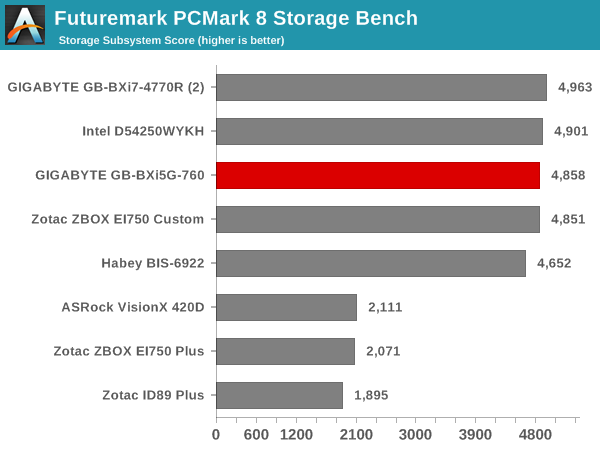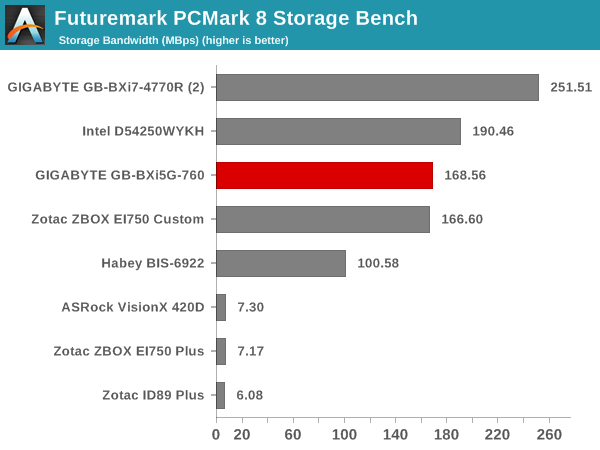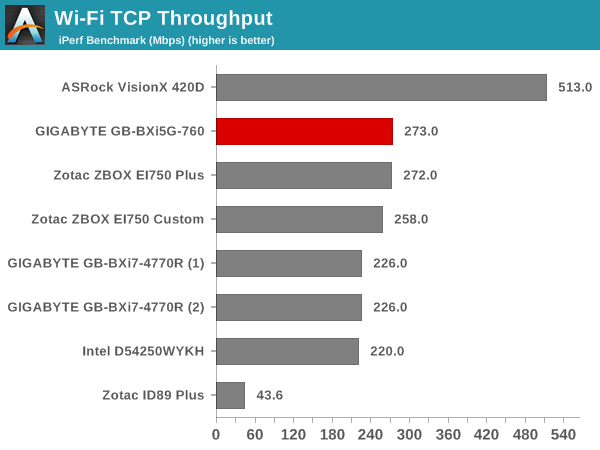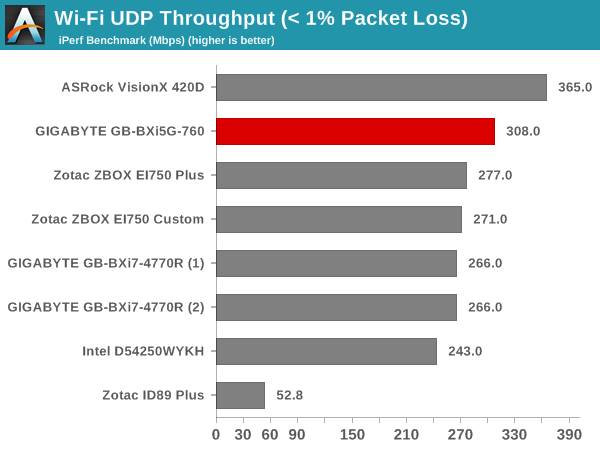GIGABYTE BRIX Gaming BXi5G-760 mini-PC Review
by Ganesh T S on September 15, 2014 2:30 PM ESTNetworking & Storage Performance
We have recently started devoting a separate section to analyze the storage and networking credentials of the units under review. On the storage side, one option would be repetition of our strenuous SSD review tests on the drive(s) in the PC. Fortunately, to avoid that overkill, PCMark 8 has a storage bench where certain common workloads such as loading games and document processing are replayed on the target drive. Results are presented in two forms, one being a benchmark number and the other, a bandwidth figure. We ran the PCMark 8 storage bench on selected PCs and the results are presented below.


The presence of a mSATA SSD greatly increases the usability of the unit if the workloads have major dependence on storage performance. Obviously, these scores depend on the drives used by the end user to complete the system configuration.
On the networking side, we restricted ourselves to the evaluation of the WLAN component. Our standard test router is the Netgear R7000 Nighthawk configured with both 2.4 GHz and 5 GHz networks. The router is placed approximately 20 ft. away, separated by a drywall (as in a typical US building). A wired client (Zotac ID89-Plus) is connected to the R7000 and serves as one endpoint for iPerf evaluation. The PC under test is made to connect to either the 5 GHz (preferred) or 2.4 GHz SSID and iPerf tests are conducted for both TCP and UDP transfers. It is ensured that the PC under test is the only wireless client for the Netgear R7000. We evaluate total throughput for up to 32 simultaneous TCP connections using iPerf and present the highest number in the graph below.

In the UDP case, we try to transfer data at the highest rate possible for which we get less than 1% packet loss.

The Wi-Fi module in both the BRIX Pro and the BXi5G-760 are the same, but the latter shows better benchmark numbers. This is possibly due to the difference in the arrangement of the antenna, as well as difference in the drivers that were used for evaluation. The major drawback for the BXi5G-760 is the presence of a 1x1 802.11ac card instead of a 2x2 that some of the other mini-PCs employ. This means that the WLAN rates are not as good as those of the 2x2-equipped VisionX 420D.










35 Comments
View All Comments
daddacool - Tuesday, September 16, 2014 - link
The sooner Gigabyte bites the bullet and does a gaming brix with watercooling the better. Until they do that, the thermal constraints make it a little pointless IMHOhojnikb - Tuesday, September 16, 2014 - link
where the hell would they put watercooling ?dj_aris - Tuesday, September 16, 2014 - link
Just invest $50 more on R&Ding better cooling on a $1000 pc, Gigabyte. Bigger fans? Bigger chassis? A tiny water cooling module? How awesome would that be.DiseasedPidgeon - Tuesday, September 16, 2014 - link
The reason they've made this small is for a living room unit. I prefer the solution provided by the G-Pack. http://piixl.comHaravikk - Monday, October 6, 2014 - link
Another waste of money from the Brix line; anything in this form factor that requires cooling is a dead end on thermal and acoustic performance. But the really weird thing is that it might not be so bad if they'd just build their own cooling system; put the CPU at the top facing down, and the GPU at the bottom facing up, sandwiching a nice big heat-sink with a built-in blower fan and you might just improve things, but two tiny fans shoved into a position they can't possibly cool properly from is not the answer.It's silly really, as machines only slightly bigger are far more compelling. The Alienware Alpha for example is still extremely small, but ought to have similar, or even better, performance for a lot less money.